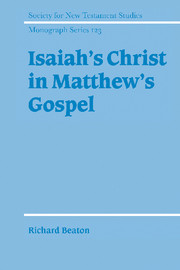Book contents
- Frontmatter
- Contents
- Preface
- List of abbreviations
- 1 Introduction
- 2 History of research
- 3 Texts and early Jewish exegesis
- 4 Isaianic formula quotations in Matthew
- 5 Isaiah 42.1–4 within the context of Matthew 11–13
- 6 The christological contribution of Isaiah 42.1–4
- 7 Conclusion
- Bibliography
- Index of passages
- Index of modern authors
- Index of subjects
3 - Texts and early Jewish exegesis
Published online by Cambridge University Press: 22 September 2009
- Frontmatter
- Contents
- Preface
- List of abbreviations
- 1 Introduction
- 2 History of research
- 3 Texts and early Jewish exegesis
- 4 Isaianic formula quotations in Matthew
- 5 Isaiah 42.1–4 within the context of Matthew 11–13
- 6 The christological contribution of Isaiah 42.1–4
- 7 Conclusion
- Bibliography
- Index of passages
- Index of modern authors
- Index of subjects
Summary
A common assumption when examining the usage of an OT passage in later literature is that such an exercise ought to be accompanied by an investigation into possible historical antecedents. This in turn helps to determine whether the passage under scrutiny is in continuity or discontinuity with other uses from the period. What is perhaps unfortunate in a task of this nature is its relative complexity, for an investigation quickly encounters various and frequent lacunae, prohibiting a complete description and yielding only tentative results. This is especially true for studies on Matthew's formula citations which, as observed earlier, are complicated by the anomalous text-forms, unusual usage and unattested introductory formulae. The situation has been eased somewhat with the publication of the texts from Masada, Naḥal Ḥever, Wadi Murabbaʿat and Khirbet Qumran and the insights these texts have afforded regarding the text-form, exegesis and hermeneutics in the period immediately prior to and contemporaneous with the composition of the New Testament. Given this state of affairs, it seems prudent to scrutinize recent investigations into the biblical text-form for any possible clues concerning Matthew's distinctive text-form and usage of biblical quotations. This method of examination, it is hoped, will set the stage for an analysis of the distinctive text of Isa. 42.1–4 in Matt. 12.18–21 and aid in determining whether the textual peculiarities were drawn from Judaism and used in support of its ideology, or whether they represent early Christian historical and/or theological reflection upon the life and times of Jesus of Nazareth.
- Type
- Chapter
- Information
- Isaiah's Christ in Matthew's Gospel , pp. 44 - 85Publisher: Cambridge University PressPrint publication year: 2002

